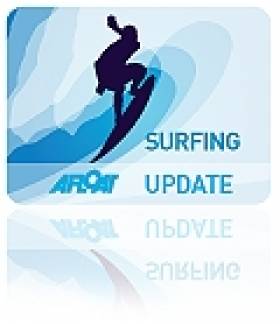Displaying items by tag: Al Mennie
'World's Biggest Waves' Off Irish Coast?
#SURFING - One of Ireland's top surfers claims he has found the world's biggest waves off the coast of Ireland.
As Irish Central reports, Portrush waverider Al Mennie says that he and surfing partner Andrew Cotton have found two waves reaching as much as 120 feet in secret locations off the coasts of Antrim and Donegal.
The duo are currently waiting for the right conditions to surf the biggest swells.
"The good days are few and far between – 90 percent of the swells are unrideable and we'd reckon that only two days each year are rideable," Mennie told the Irish Independent.
Their location is being kept under wraps for now due to safety concerns, as the waves crash down in a hazardous rocky area - making them definitely not suitable for novices.
Irish Central has more on the story HERE.
Surfers Take On Big Waves in Sligo
More than 20 of Ireland's and Europe's top surfers took on the monster waves at Sligo’s Mullaghmore Head at the weekend in Ireland's first ever 'big wave' surf contest.
The Tow-in Surf Session was organised by the Irish Surf Rescue Club in part to dispel the myth that tow-in surfing - where surfers are towed by jetski to bigger offshore waves - is an irresponsible activity.
Club president Paul O’Kane told The Irish Times: “Our surf riders and personal watercraft operators are all very safety conscious, highly trained, and contests like this can help to further develop skill sets.”
Eric Ribiere and Benjamin Sanchis from France took top place in the open category in a contest that rewarded skill and commitment on the biggest waves. Peter Conroy and Gyln Ovens came first in the Irish division, follwed closely by Al Mennie and Andrew Cotton.
Awards went to professional boarder Gabe Davies for best wave, Al Mennie for best barrel and Richie Fitzgerald for heaviest wipeout.
Easkey Britton also held her own as the only female competitor on the day, catching a solid 20-foot wave.
Click HERE for more video of the contest's big wave surfing action.
Al and Cotty Take On Giant Wave
The surfing website MagicSeaweed has posted a breathtaking pictorial of boarders Al Mennie and Andrew Cotton taking on the incredible Finn MacCools wave at the Giant's Causeway.
"The funny thing is this wave has been breaking right under our noses for years at Northern Ireland's premier tourist spot!" said Mennie. "It's one of those mythical places people often mention, wondering if there are waves out here."
'Al' and 'Cotty' were among the surfers who discovered the now-famous Prowlers wave off the west coast of Ireland last year - the exact location of which is still a closely-guarded secret. SEE VIDEO BELOW
More photos and vide on this story HERE


























































